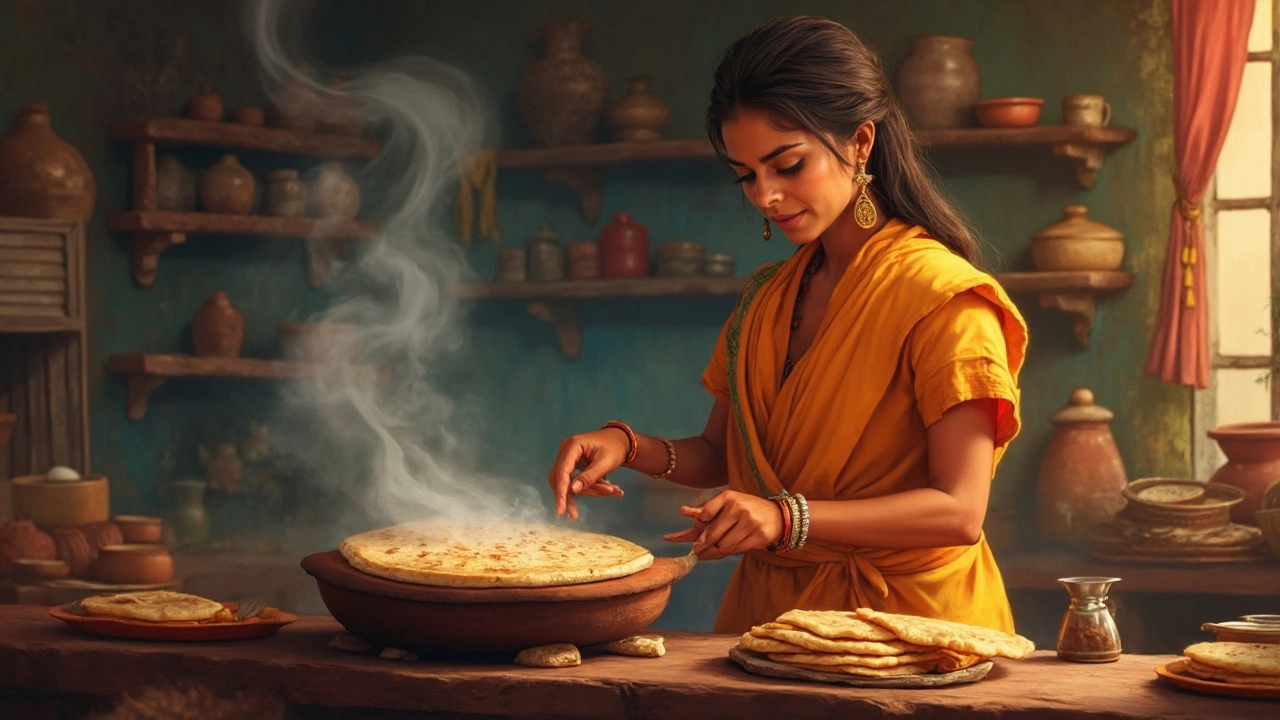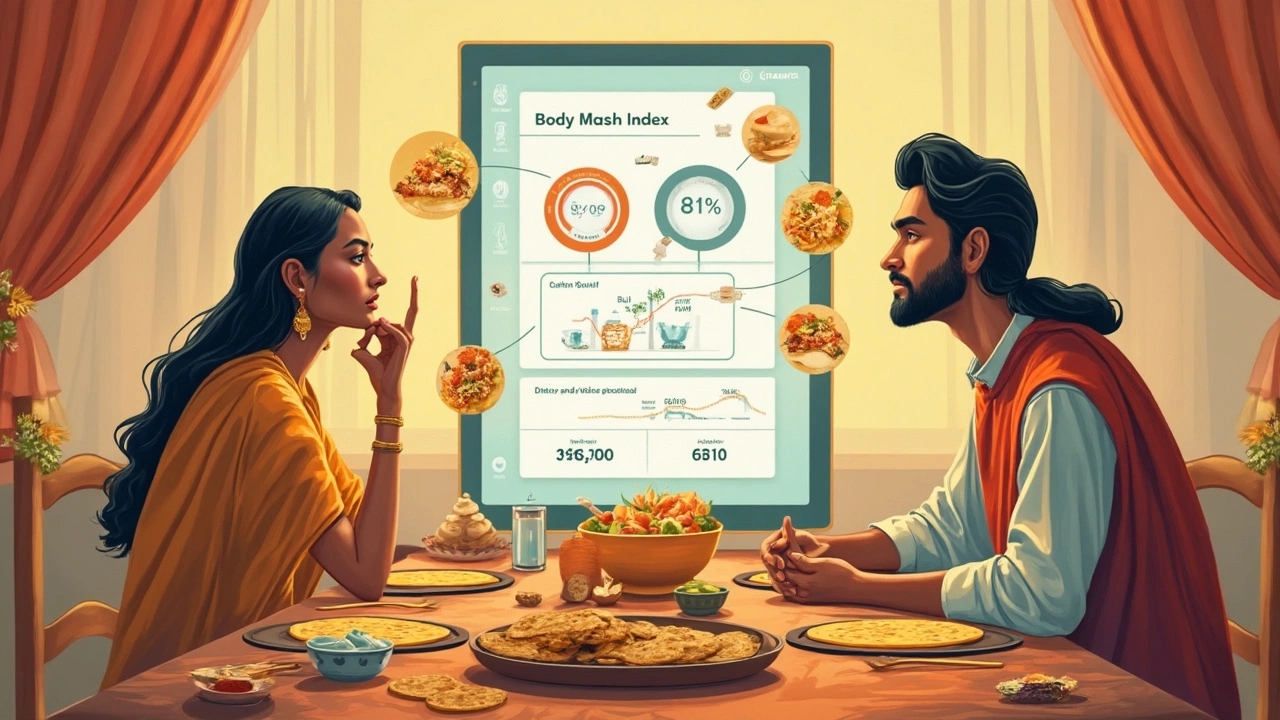Chapati Consumption: How Many Are Too Many?
 Feb, 28 2025
Feb, 28 2025
Ever wondered if you’re overdoing it with the chapatis at dinner? Let's break it down! The basics include considering the calories in one roti and your Body Mass Index (BMI). If you're scratching your head about how to figure this out, don't worry—it's not rocket science!
Firstly, what's a chapati packing in terms of calories? Well, on average, one roti clocks in at around 70-80 calories. Now, this may not seem like a lot, but it does add up if you’re having a few more than usual. Here’s where knowing your needs comes in handy.
To gauge your dietary requirements, you'll need to take a look at your calorie calculator. Yep, the same tool you might hate but need to stay healthy! It helps tailor your intake by considering factors like age, weight, height, and activity level and plays into what’s deemed your ideal serving of chapatis.
So, how many chapatis should one really eat in a day? It circles back to your BMI—a neat little number that says a lot about whether you’re on track with your weight. Keeping an eye on it can ensure those tasty rotis aren’t tipping the scale.
- Understanding Chapati Nutrition
- Calculating Calorie Needs
- Using a Calorie Calculator
- Health Guidelines & BMI
- Legal and Local Aspects of Chapati Consumption
Understanding Chapati Nutrition
Chapatis are a staple in many Indian households, often enjoyed with various curries and sides. But what's inside this beloved bread? Let's unwrap its nutritional layers!
Basic Nutritional Composition
A single chapati is primarily made of whole wheat flour, which is loaded with fiber and essential nutrients. On average, one chapati comprises about 15 grams of carbohydrates, 3 grams of protein, and less than 1 gram of fat, amounting to roughly calories in one roti.
| Nutrient | Amount per Chapati |
|---|---|
| Carbohydrates | 15g |
| Protein | 3g |
| Fats | <1g |
Why Chapatis are a Good Choice
Chapatis are low in calories compared to other carb-heavy foods like rice or bread. They help in maintaining a balanced diet, especially if you are keen on managing your BMI. It's a good call to go for them if you're watching your calorie intake.
How to Choose the Right Flour
- Opt for whole wheat flour for its fiber content. This helps digestion and can keep you feeling full longer.
- Check local legal guidelines on food labeling to ensure your flour source is genuine. Some brands might mislead you with "multigrain" or "high-fiber" labels without actually delivering the benefits.
Legal Aspects of Chapati Ingredients
Staying informed about what's in your chapati ties back to food safety standards. Local laws require proper labeling of food items for transparency. Be aware of what additives or preservatives might sneak into your flour, even for something as basic as a chapati.
Swapping white rice or other starchy foods for chapati consumption could be a smart move. Not only are they nutritious, but they’re also a local favorite, sustaining families while keeping the diet healthy. Keep these facts in mind next time you roll out some dough!
Calculating Calorie Needs
Alright, let's talk numbers! Knowing how many calories you need is the first step to managing how many chapatis should you eat in a day. It essentially boils down to three things: your basal metabolic rate (BMR), your physical activity level, and your health goals.
Step-by-step Guide to Calculate Your Calorie Needs
- Know Your BMR: This measures the number of calories your body needs at rest. There are loads of online calorie calculator tools that can help you figure this out.
- Add Activity Level: Use a calculator that factors in your daily activities from light exercise to heavy-duty workouts.
- Set Your Goals: Whether you're aiming to maintain, lose, or gain weight, set your goals to calculate your final calorie needs.
Legal Aspects: Food Labeling
Now, here’s the legal scoop! You might have noticed that food packaging in many places, including India, must display nutritional information by law. This helps us know exactly what's going into our bodies.
Not only is this a legal requirement, but it’s also for public awareness. Double-check those labels to ensure your BMI isn't taking an unexpected hit due to hidden calories.
Local Tips: Indian Chapati Guidelines
What about local guidelines? Well, experts often recommend that carbs make up about 45-65% of your daily calorie intake. In India, this translates to a few chapati servings, depending on your body's needs calculated through your BMI and calorie calculation.
Curious about how your typical meal stacks up? Here’s a quick breakdown:
| Item | Calories |
|---|---|
| One Roti | 70-80 |
| Lentil Curry (1 bowl) | 170 |
| Vegetable Curry (1 bowl) | 120 |
As part of a balanced diet, figure these numbers into your overall daily calorie limit, and you'll be on the path to healthier chapati consumption.

Using a Calorie Calculator
So, you're ready to use a calorie calculator to figure out how many chapatis to munch on without tipping the scale. Here's how you get started.
Step-by-Step Guide
- Get your details ready. You'll need your age, weight, height, and how active you usually are.
- Find a reliable calorie calculator online. There's a bunch out there, but stick to ones from credible health sites.
- Input your measurements and hit that calculate button!
- Now, here's the magic number—the daily calories you should aim for. Use it as your guide.
- Remember, one chapati has about 70-80 calories, so keep your BMI in mind while planning meals.
An interesting tidbit: A study by the National Institute of Nutrition suggests that for adults with moderate activity levels, a daily intake of about 2000-2200 calories is typical. Of course, this can vary based on various factors.
"Understanding your calorie needs is fundamental to maintaining a balanced diet. It tailors your food choices and can help with weight management," states Dr. Priya Patel, a renowned dietitian in India.
Legal and Local Aspects
On the local front, food labeling laws in India require nutritional information on packaged foods, including calorie count, which is handy. However, for fresh foods like homemade chapatis, you're on your own, relying on reliable sources or nutrition databases.
In Maharashtra, for example, local health departments encourage the use of calorie calculators in urban wellness programs. Keeping track of your dietary intake is not just a legal requirement but a cultural shift towards healthier living.
The key is balance—keeping an eye on Body Mass Index (BMI), especially when chapati counts start piling up!
Health Guidelines & BMI
Alright, let's get real about our health guidelines and how our Body Mass Index (BMI) plays a role in managing our chapati intake. You might think it’s just about stuffing yourself till you’re full, but there's more strategy to it. Here’s a lowdown on tailoring your chapati count to your BMI.
Step-by-Step on Managing Chapati Intake
- Know Your BMI: Start by calculating your BMI. It’s a simple metric using your height and weight to see if you’re in the healthy range. A BMI between 18.5 and 24.9 is generally considered healthy.
- Understand the Impact: If your BMI is above this range, it may contribute to health issues. Keeping an eye on how many chapatis you're consuming can help maintain a balanced diet without going overboard.
- Check Calorie Needs: Use a calorie calculator to figure out your daily needs based on your lifestyle. For instance, a moderately active person might need around 2000-2500 calories per day.
- Balance with Other Foods: Ensure your diet isn’t just all chapatis, include veggies, proteins, and fats to strike a balance.
Legal and Local Aspects
When it comes to food, there are local dietary guidelines many folks often miss. For example, in India, the National Institute of Nutrition suggests an average adult should limit staple foods, like chapatis, within a balanced diet pyramid. On the legal front, food labeling acts are stringent about displaying nutritional info, which helps you make informed choices.
Staying on Track
So, how do you keep tabs? Some like to set a rule of thumb—say, 2-3 chapatis per meal, depending on other foods included. Yes, the idea is to enjoy your meal but with some responsibility.
In summary, leveraging your BMI and local guidelines can help you figure out your ideal number of chapatis. It’s not about depriving yourself but making sure you're getting a good balance. Got that? Great!

Legal and Local Aspects of Chapati Consumption
When we're talking about chapati consumption, it’s not just about the health angle, there's a bunch of other stuff to think about too, including some legal loops. First off, did you know that there are guidelines about what can actually be called a 'chapati'? Sounds intense, right? But it’s part of ensuring quality and authenticity.
Labelling and Food Safety
Let's start by discussing food safety. Regulations call for proper labeling on food products, including those related to chapatis. The ingredients, nutritional details like calories in one roti, and sometimes even the traditional recipe should be mentioned. For those munching on store-bought chapatis, this info is crucial to make informed choices and manage their BMI.
Local Dietary Guidelines
Locally, Indian dietary guidelines suggest a balance between carbohydrates, proteins, and fats. Chapatis often show up here, but it's how you combine them with other food groups that really plays into health. Eating them with a good serving of veggies or proteins helps round out nutrition.
Legal Guidelines on Wheat and Grain Standards
Here's a lesser-known fact: there are standards for the wheat used to make chapatis! Yep, different grains have to meet specific criteria to ensure we aren’t eating chalk instead of wheat. This affects the dough’s quality and, in turn, the final product.
How to Navigate the Chapati Maze
- Always check labels for nutritional info and ingredient lists, especially to spot any allergens.
- Look out for local certifications on the packaging, which implies adherence to local food standards.
- Be aware of any recalls or food safety alerts related to chapati products.
- Balance chapati intake with local dietary recommendations to maintain your Body Mass Index (BMI).
All of this might seem a tad overwhelming, but knowing these legal and local aspects ensures that your chapati, whether home-cooked or store-bought, is a safe bet for your health.
| Aspect | Details |
|---|---|
| Nutritional Info on Labels | Mandatory |
| Local Dietary Guidelines | Include chapatis as part of a balanced diet |
| Grain Standards | To ensure quality and safety |